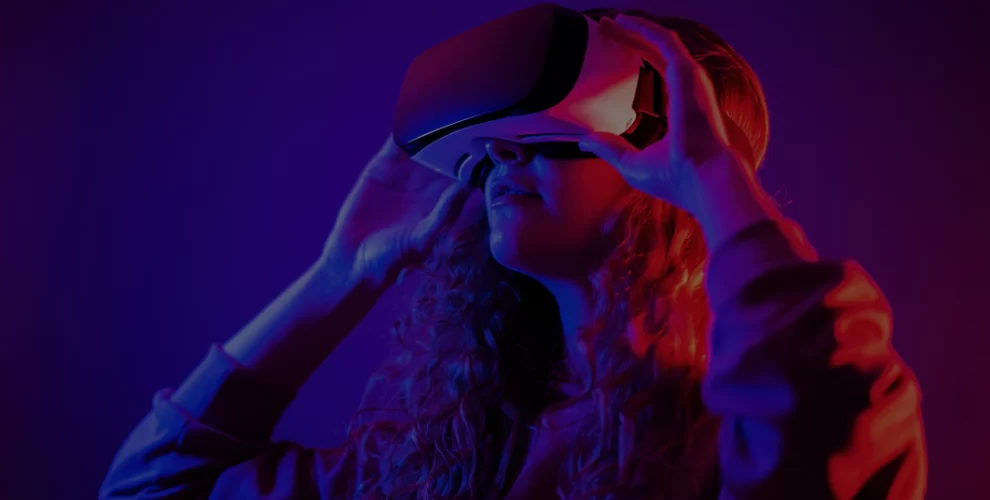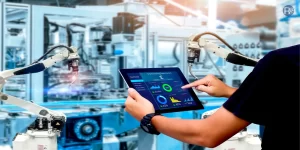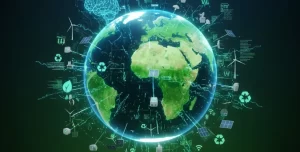
What is VR (Virtual Reality) and How Does It Work?
Table of Contents
Introduction
Welcome to WikiGlitz!
From gaming and entertainment to education and healthcare, VR is reshaping how we interact with digital environments.
In this comprehensive guide, we will explore the basics of VR, its workings, and its wide-ranging applications.
Key Takeaways
- Understanding VR Technology:Virtual Reality (VR) creates immersive, computer-generated environments that simulate real-world experiences using a combination of hardware (like headsets and motion controllers) and software (AI algorithms and graphics).
- Diverse Applications:VR has broad applications across various industries, including gaming, education, healthcare, real estate, and marketing. It enhances learning, training, entertainment, and virtual tours by providing interactive and engaging experiences.
- Future Potential:Despite challenges like high costs and technical limitations, VR technology is rapidly advancing. Emerging trends and innovations promise to make VR more accessible, immersive, and impactful, transforming how we interact with digital and physical worlds.
What is Virtual Reality?
Definition and Explanation of VR
Virtual Reality (VR) is a technology that creates a simulated environment using computer-generated imagery and sounds, allowing users to experience and interact with a 3D world that mimics or differs from the real world.
By wearing a VR headset, users can immerse themselves in these digital landscapes, experiencing sights and sounds as if they were physically present in that environment.
Brief History of VR Development
Over the decades, VR technology has evolved significantly, with major milestones including the development of the Oculus Rift in 2010, which brought VR into the consumer market, and subsequent advancements by companies like HTC, Sony, and Meta (formerly Facebook).
How Does Virtual Reality Work?
Overview of VR Technology
VR technology operates by replacing the real-world environment with a virtual one, using a combination of hardware and software to create an immersive experience.
The key to this immersive experience is the synchronization of visual and auditory stimuli with the user’s movements.
Hardware Components
- VR Headsets: The most crucial component of a VR system is the headset, which houses screens and lenses to create the 3D effect. Modern VR headsets like the Meta Quest and HTC Vive provide high-resolution displays and wide fields of view to enhance immersion.
- Motion Controllers: They are equipped with sensors to detect movements and gestures, enabling actions like picking up objects or navigating through the virtual space.
- Sensors and Tracking Systems: These devices track the user’s head and body movements to adjust the virtual environment accordingly. Common tracking systems include external sensors placed around the room or built-in sensors in the headset itself.
Software Components
- AI Algorithms: Advanced AI algorithms play a crucial role in rendering realistic virtual environments. They help in creating responsive and dynamic interactions within the virtual world.
- Computer-Generated Graphics and Audio: High-quality graphics and spatial audio are essential for creating a believable VR experience. These elements are generated in real-time to match the user’s movements and actions, ensuring seamless immersion.
Types of Virtual Reality
Fully Immersive VR
Fully immersive VR provides the most realistic and engaging experience, completely surrounding the user with a virtual environment.
Users wear VR headsets equipped with high-resolution displays, motion sensors, and sometimes even haptic feedback systems to simulate touch.
This type of VR is commonly used in gaming and training simulations, where complete immersion is crucial.
Semi-Immersive VR
Semi-immersive VR offers a partially immersive experience by combining elements of both virtual and physical environments.
Users might interact with virtual objects overlaid on their real-world surroundings, often using headsets with less sophisticated motion tracking.
This type of VR is frequently used in educational settings and flight simulations.
Non-Immersive VR
Non-immersive VR provides the least immersive experience, typically involving interaction with a virtual environment via a standard computer screen or projection system.
Users might use a keyboard, mouse, or joystick to control their interactions.
Examples include VR video games played on a PC without a VR headset and driving simulators.
Differences Between VR, AR, and MR
Augmented Reality (AR)
AR overlays digital information onto the real world, enhancing the user’s perception of their environment.
Unlike VR, which creates a completely separate environment, AR adds virtual elements to the physical world.
Common applications include smartphone apps like Pokémon GO and AR navigation systems.
Mixed Reality (MR)
MR combines aspects of both VR and AR, allowing digital and real-world elements to interact in real-time.
Users can manipulate virtual objects as if they were part of the real world, often using advanced headsets like the Microsoft HoloLens.
MR is used in fields such as product design and interactive training.
Key Distinctions
- VR: Fully immersive, creating a separate digital environment.
- AR: Enhances the real world with digital overlays.
- MR: Integrates digital and physical elements, allowing interaction between them.
Key Components of VR Systems
VR Headsets and Displays
VR headsets are the primary interface for experiencing virtual reality.
They feature stereoscopic displays that provide separate images for each eye, creating a 3D effect. High-end headsets like the Meta Quest and HTC Vive offer high resolutions and wide fields of view to enhance realism.
Motion Tracking and Sensors
Motion tracking systems use sensors to detect the user’s movements and adjust the virtual environment accordingly.
Common tracking methods include infrared sensors, gyroscopes, and accelerometers. Advanced systems like the Valve Index use external base stations to track movements with high precision.
Haptic Feedback Systems
Haptic feedback systems provide tactile sensations to simulate touch in the virtual environment. These systems use vibration motors and other mechanisms to replicate the feeling of interacting with virtual objects.
Haptic gloves and vests are examples of devices that enhance immersion through touch.
Spatial Audio
Spatial audio technology creates a 3D sound environment that matches the visual experience. By adjusting the direction and distance of sounds, spatial audio enhances the sense of presence in VR.
This technology is essential for creating realistic simulations and immersive experiences in gaming and training.
Applications of Virtual Reality
Gaming and Entertainment
VR has revolutionized the gaming and entertainment industry by offering players immersive experiences that traditional platforms can’t match.
Games like “Beat Saber” and “Half-Life: Alyx” fully utilize VR’s capabilities, providing players with an engaging and interactive environment.
In addition to gaming, VR is used in virtual concerts, cinematic experiences, and theme park attractions, where users can explore fantastical worlds and scenarios.
Education and Training
VR is a powerful tool for education and training, providing students and professionals with hands-on experiences that are otherwise impossible or impractical.
In education, VR can simulate historical events, scientific experiments, and virtual field trips.
For professional training, VR offers safe and controlled environments for practicing high-risk tasks such as surgical procedures, flight simulations, and military training.
Healthcare
In healthcare, VR is used for various applications, including therapy, rehabilitation, and medical training.
VR therapy helps patients with anxiety, PTSD, and phobias by exposing them to controlled virtual environments. Rehabilitation programs use VR to aid in the recovery of motor skills for stroke patients and those with physical injuries.
Additionally, medical students and professionals use VR to practice surgeries and other complex procedures without risk to real patients.
Real Estate and Architecture
VR allows real estate agents and architects to provide virtual tours of properties and buildings.
Potential buyers can explore homes and commercial spaces from anywhere in the world, gaining a better sense of the property’s layout and features.
Architects use VR to visualize and refine their designs, presenting clients with immersive walkthroughs that showcase their projects before construction begins.
Tourism and Hospitality
The tourism and hospitality industry uses VR to offer virtual tours of destinations and accommodations.
Travelers can explore cities, landmarks, and hotels virtually before making booking decisions.
VR experiences can also be used to market destinations by providing immersive previews that entice potential visitors.
Marketing and Advertising
VR is increasingly being used in marketing and advertising to create memorable and interactive campaigns.
Brands can develop virtual experiences that engage consumers and promote their products in innovative ways.
Examples include virtual showrooms, interactive product demonstrations, and immersive storytelling experiences that enhance brand awareness and customer engagement.
Popular VR Headsets
Meta Quest Series
The Meta Quest series, including the Quest 2 and Quest 3, are popular standalone VR headsets known for their high performance and ease of use.
They offer wireless freedom, high-resolution displays, and a wide range of applications, making them a top choice for both casual users and VR enthusiasts.
Pico Neo Series
Pico Neo headsets are known for their ergonomic design, high-resolution displays, and strong performance.
They are used in both consumer and enterprise markets, offering a versatile platform for gaming, training, and professional applications.
HTC Vive Series
The HTC Vive series includes the Vive Pro 2 and Vive Cosmos, known for their advanced features and high-quality VR experiences.
These headsets provide excellent resolution, field of view, and tracking capabilities, making them suitable for gaming, professional use, and enterprise applications.
PlayStation VR Series
Sony’s PlayStation VR series, including the PlayStation VR and the upcoming PlayStation VR2, offers high-quality VR gaming experiences for PlayStation console users.
These headsets are known for their immersive gameplay, wide range of compatible games, and integration with the PlayStation ecosystem.
Apple Vision Pro
The Apple Vision Pro is a high-end AR/VR headset that offers cutting-edge technology and features.
With advanced hand tracking, eye tracking, and spatial audio, the Vision Pro provides an immersive experience for various applications, from gaming and entertainment to professional use. However, its high price point makes it a premium option.
VR Software Solutions
VR Content Creation Tools
Creating VR content requires specialized tools and software that allow developers to design and implement immersive experiences.
Popular VR content creation tools include Unity and Unreal Engine, which provide powerful frameworks for building VR applications.
These tools offer a range of features, including 3D modeling, animation, and physics simulations.
Game Engines (Unity, Unreal Engine)
Unity and Unreal Engine are two of the most popular game engines used for VR development.
Unity is known for its user-friendly interface and wide range of supported platforms, making it accessible for beginners and professionals alike.
Unreal Engine offers high-quality graphics and advanced features, making it a preferred choice for creating photorealistic VR environments.
Industry-Specific VR Applications
Different industries require tailored VR applications to meet their unique needs.
For example, the healthcare industry uses VR for surgical simulations and therapy, while the real estate industry uses VR for virtual property tours.
Custom VR software solutions are developed to address these specific requirements, ensuring that VR technology is effectively integrated into various fields.
Benefits of Virtual Reality
Enhanced Learning Experiences
VR offers unparalleled opportunities for interactive and immersive learning.
By providing realistic simulations and environments, students can engage with complex subjects like never before.
For instance, medical students can perform virtual surgeries, while history students can explore ancient civilizations in a virtual setting, enhancing their understanding and retention of information.
Improved Training Simulations
Training simulations in VR offer a safe, cost-effective, and realistic way to practice skills and procedures.
This is particularly valuable in fields where hands-on experience is crucial, such as aviation, medicine, and military training.
Trainees can repeatedly practice scenarios in a controlled environment, reducing risks and improving their proficiency before applying their skills in real-world situations.
Immersive Entertainment
VR brings a new dimension to entertainment, making experiences more engaging and interactive.
In addition to gaming, VR is used for virtual concerts, theater performances, and immersive movies, allowing users to feel as if they are part of the action.
This level of immersion enhances enjoyment and offers new possibilities for storytelling and audience engagement.
Realistic Virtual Tours
VR enables realistic virtual tours of real estate properties, tourist destinations, and historical sites, allowing users to explore these locations remotely.
This is particularly beneficial for prospective homebuyers, travelers, and students, providing them with a detailed view and better understanding of the spaces without the need for physical presence.
Challenges and Limitations of VR
High Cost of Equipment and Development
One of the significant barriers to widespread adoption of VR is the high cost of equipment and development.
High-quality VR headsets, motion controllers, and powerful computers required for running sophisticated VR applications can be expensive.
Additionally, creating high-quality VR content requires specialized skills and resources, making development costly and time-consuming.
Accessibility and Availability
While VR technology is advancing rapidly, it is not yet equally accessible to everyone.
Many people in developing countries or those with lower incomes may find it challenging to afford the necessary equipment.
Moreover, the availability of VR content and experiences varies, with more options typically available in developed regions.
Health Concerns (Motion Sickness)
VR can cause motion sickness and other adverse health effects in some users, especially during prolonged use.
Symptoms such as nausea, dizziness, and eye strain can limit the duration and enjoyment of VR experiences.
Developers are continually working to reduce these issues through improvements in frame rates, latency, and motion tracking, but they remain a concern for some users.
Technical Limitations (Computing Power, Latency)
The effectiveness of VR experiences depends heavily on computing power and latency.
High-quality VR requires powerful processors and graphics cards to render detailed environments and maintain high frame rates.
Latency, or the delay between a user’s action and the system’s response, must be minimized to avoid disrupting the immersive experience. These technical demands can be challenging to meet, especially in standalone VR systems.
The Future of Virtual Reality
Emerging Trends in VR Technology
The future of VR is promising, with several emerging trends poised to enhance its capabilities and applications.
Advances in artificial intelligence, machine learning, and graphics processing will enable more realistic and responsive virtual environments.
Additionally, developments in haptic feedback, spatial audio, and eye tracking will further improve immersion and user experience.
Potential Advancements and Innovations
Future VR innovations are expected to include more sophisticated motion tracking, allowing for more natural and intuitive interactions within virtual environments.
Wireless VR headsets with improved battery life and performance will offer greater freedom and convenience.
Augmented reality (AR) and mixed reality (MR) technologies will continue to evolve, blending digital and physical worlds in new and exciting ways.
Impact on Various Industries
As VR technology advances, its impact on various industries will grow. In education, VR will enable more immersive and interactive learning experiences.
In healthcare, VR will enhance medical training, patient therapy, and surgical planning.
The entertainment industry will see new forms of immersive content, while industries like real estate, tourism, and marketing will leverage VR to provide unique and engaging experiences for their audiences.
Conclusion
Virtual Reality (VR) is a transformative technology with the potential to revolutionize various aspects of our lives. From gaming and entertainment to education and healthcare, VR offers immersive experiences that enhance learning, training, and enjoyment.
Despite challenges such as high costs and technical limitations, the future of VR is bright, with ongoing advancements promising even more exciting and impactful applications.
As VR technology continues to evolve, it will undoubtedly play an increasingly significant role in shaping the way we interact with the digital and physical worlds. WikiGlitz has brought you this insight to help you navigate the fascinating world of VR.
FAQs
What is the difference between VR and AR?
VR (Virtual Reality) creates a fully immersive digital environment, while AR (Augmented Reality) overlays digital elements onto the real world, enhancing the user’s perception of their surroundings.
How do VR headsets work?
VR headsets work by displaying computer-generated images on screens in front of the user’s eyes, creating a 3D effect. They use motion sensors and tracking systems to detect head movements and adjust the view accordingly.
What are the main applications of VR?
VR is used in gaming, education, healthcare, real estate, tourism, marketing, and more. It provides immersive experiences for training, therapy, virtual tours, and interactive entertainment.
What are the challenges of using VR?
Challenges include high costs of equipment and development, accessibility issues, health concerns such as motion sickness, and technical limitations like computing power and latency.
Want to keep up with our blog?
Our most valuable tips right inside your inbox, once per month.
Error: Contact form not found.
WikiGlitz Team
Welcome to WikiGlitz, your ultimate destination for tech insights and innovation. Our expert team is dedicated to delivering free resources and professional advice on various technology topics, including Artificial Intelligence, Cyber Security, Cloud Computing, and more. We strive to empower our readers with up-to-date information and practical guidance, ensuring you stay ahead in the rapidly evolving tech landscape. At WikiGlitz, we are passionate about making complex technology accessible to everyone. Our team of seasoned experts curates content that is both informative and engaging, helping you understand and leverage the latest tech trends. Whether you're a tech enthusiast or a professional, WikiGlitz is your go-to source for reliable, expert-driven content. Join us on this journey to explore and embrace the future of technology.





